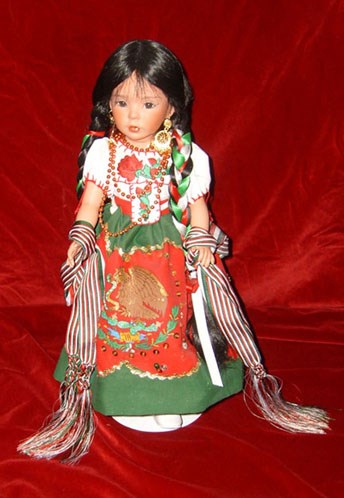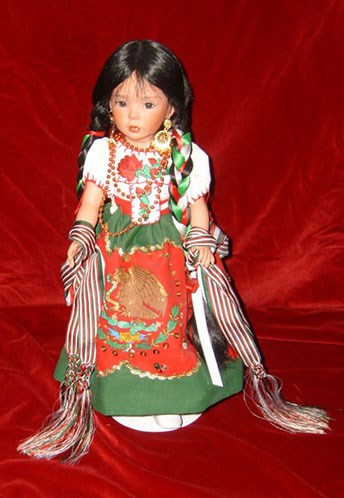
Capital: Puebla Ribbons weave the colors of the Mexican flag into the long braid; and both the white blouse and the long full skirt - dark green at waist and hem with a sequined red field between - bear bold embroidered Mexican eagles. This proud statement reflects both the influence of Puebla's indigenous people and the state's connection to the War of Independence. The Nahuas, the largest group of indigenous people in Mexico, are concentrated in Puebla, Morelos, Tlaxcala, and Mexico. The Nahuas carried the powerful influence of the Aztec culture through the Spanish conquest and into modern day Mexico. The Otomi live in various areas of the country, but principally in Puebla, Mexico, Hidalgo, Tlaxcala, and Veracruz. Many Otomies live in poverty, building their homes from the large spiny leaves of the maguey and cultivating the plant to produce pulque, an alcoholic drink. Most of the Tepehuas and Totonacos live in Veracruz and Puebla. Though large numbers have moved to the cities, more than 200,000 still live in their place of origin. In a tiled fountain on the northern end of Puebla, a statue keeps alive the memory of a non-indigenous but legendary figure, La China Poblana. Mirrha (her real name) was actually born in Delhi, India in 1609. Kidnapped by pirates at the age of nine, she was sold to a Portuguese merchant in Manila who shipped her to Puebla. There, Miguel Sosa and his wife, who had commissioned the merchant to send them a "little Chinese girl", adopted Mirrha in 1620, when she was eleven, and baptized her Catarina de San Juan. Catarina married Domingo Suarez. She died in 1688. It was not her strange journey to Puebla, but her many acts of charity that established her legacy. In northeast Puebla, many lakes formed within volcanic craters, which the indigenous people call axalapascos. the mineral waters of Puebla's natural springs are thought to have healing properties, and the mineral waters of Tehuacan are used to make soft drinks. Puebla's industrial activities include bottling soft drinks, chemical and petrochemical plants, food processing, and automotive plants. The city of Talavera is world famous for its distinctive ceramic pottery, intricately decorated and brilliantly colored. the pottery originated in Spain, but Talaveran artisans mastered the technique and developed their own unique designs. In southeast Puebla, El Mar del Tiempo (the Sea of Time) holds fossils of ocean creatures left behind from when the Gulf of America and the Pacific Ocean met across the land. Puebla shares several of the highest peaks in Mexico with neighboring states: the Citlaltepetl or Pico de Orizaba with Veracruz; Popocatepetl and Iztaccihuatl with the state of Mexico and Morelos; and Malinche with Tlaxcala. Did you know...? 
Capital: Puebla Los listones de la trenza ondead los colores de la bandera mexicana y tanto la blusa blanca como la falda larga, de color verde oscuro en la cintura y rojo en el dobladillo, muestran un bordado al frente con dos valientes águilas mexicanas. Esta orgullosa manifestación refleja la influencia de la gente indígena de Puebla, y la conexión del estado, a la Guerra de Independencia. Los Nahuas son el grupo indígena más numeroso, y viven principalmente en Puebla, Morelos, Tlaxcala, y México. Este grupo indígena ha conservado la influencia de la cultura azteca a pesar de la conquista española y ha permanecido hasta nuestros días donde se han integrado a la población general manteniendo una conexión con sus raíces. Los Otomíes viven principalmente en Puebla, Hidalgo, Tlaxcala, Veracruz, y México. Muchos viven en la pobreza, cultivan el maguey (también llamado agave), construyen sus casas con las grandes hojas espinosas y también lo usan para producir pulque, una bebida alcohólica. La mayor parte de los Tepehuanes y Totonacos viven en Veracruz y Puebla. Aunque muchos han emigrado a las ciudades, más de 200,000 indígenas viven todavía en su lugar de origen. En una fuente al norte de Puebla, una estatua mantiene viva la memoria de un figurea no indígena pero legendaria, La China Poblana, Mirrha (su verdadero nombre) en realidad nació en Delhi, India, en 1609. Secuestrada por piratas a la edad de nueve años fue vendida a un comerciante portugués en Manila quien la embarcó a Puebla. Allí, Miguel Sosa y su esposa, habían comisionado al comerciante a que les enviara "una pequeña muchacha china", adoptaron a Mirrha en 1620, cuando tenía once años, la bautizaron con el nombre de Catarina de San Juan. Catarina se caso con Domingo Suárez. Murió en 1688. No fue su extraña llegada a Puebla, sino sus actos de caridad lo que constituyó su legado. En el noreste de Puebla, se han formado muchos lagos dentro de cráteres volcánicos, que los indígenas llaman axalapascos. Se cree, que las aguas minerales de los manantiales naturales de Puebla, poseen propiedades curativas y las aguas minerales de Tehuacán son usadas para hacer refrescos. Las actividades industriales de Puebla incluyen refrescos embotellados, plantas químicas y petroquímicas, industria alimenticia y plantas de automóviles. La ciudad de Talavera es mundialmente famosa por su característica cerámica, intrincada e intensamente coloreada. Aunque es originaria de España, los artesanos de Talavera han dominado la técnica y han creado sus propios diseños. En el sudeste de Puebla, el Mar del Tiempo, mantiene los fósiles de criaturas del océano olvidadas cuando el Golfo de México y el Océano Pacífico estaban unidos. Puebla comparte varios de los picos más altos de México con estados vecinos: el Citlaltépetl o Pico de Orizaba con Veracruz; Popocatépetl e Iztaccíhuatl con el Estado México y Morelos; y la Malinche con Tlaxcala. Sabias que...? |
Last updated: February 18, 2025
